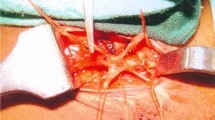Abstract
This study was carried out to determine the subsequent fate of the greater saphenous vein and the efficacy of its high ligation along with surgical excision or sclerotherapy of varicosities. From 1988 to 1990, 22 patients underwent high ligation and sclerotherapy, 22 underwent high ligation and varicose vein excision, and four underwent high ligation alone. There were 36 women and 12 men patients. The average patient age was 48. Sixty limbs were scanned by duplex ultrasound pre- and postoperatively to determine the status of the greater saphenous vein. Average follow-up time was 10 months. Patients and surgeons rated the results of therapy for ablation of varicosities and alleviation of symptoms. Surgical complications were evaluated. At postoperative scan, 47 greater saphenous veins (78%) were found to be completely patent, nine (15%) were thrombosed for a short segment (less than 10 cm) and four (7%) were more significantly thrombosed. Those limbs in which high ligation and sclerotherapy were performed had the highest complete patency rate (96%). Patient and surgeon satisfaction was good to excellent in every case. The only complications were three symptomatic greater saphenous vein thromboses. Although follow-up is relatively brief, complete patency of the ligated greater saphenous vein was found in most cases. High ligation allows preservation of a patent greater saphenous vein, which can be used as an arterial conduit at a later date and gives therapeutic results comparable to stripping without the additional morbidity.
Similar content being viewed by others
References
CRANE C. The surgery of varicose veins.Surg Clin N Am 1979;59:737–748.
KEITH LM Jr, SMEAD WL. Saphenous vein stripping and its complications.Surg Clin N Am 1983;63:1303–1312.
FEGAN WG. Continuous compression technique of injecting varicose veins.Lancet 1963;2:109–112.
HOBBS JT. The treatment of varicose veins by sclerosing therapy. In: RUTHERFORD RB (ed).Vascular Surgery. Philadelphia: W. B. Saunders, 1984; pp 1332–1347.
JAKOBSEN BH. The value of different forms of treatment for varicose veins.Br J Surg 1979;66:182–184.
LARGE J. Surgical treatment of saphenous varices with preservation of the main great saphenous trunk.J Vasc Surg 1985;2:886–891.
SLADEN JG. Flush ligation and compression sclerotherapy for control of venous disease.Am J Surg 1986;152:535–538.
LOFGREN E. Treatment of long saphenous varicosities and their recurrence: a long-term follow-up. In: BERGAN JJ, YAO JST (eds).Surgery of the Veins. Orlando: Grune and Stratton, 1985; pp 285–299.
NUNN SR, MORTON JB, MacBETH WAAG, et al. To strip or not to strip the long saphenous vein? A varicose veins trial.Br J Surg 1981;68:426–428.
SLADEN JG. Compression sclerotherapy: preparation, technique, complications and results.Am J Surg 1983;146:228–232.
TOLINS SH. Treatment of varicose veins, an update.Am J Surg 1983;145:248–252.
HAMMARSTEN J, PEDERSEN P, CEDERLUND C-G, et al. Long saphenous vein saving surgery for varicose veins. A long-term follow-up.Eur J Vasc Surg 1990;4:361–364.
KOYANO K, SAKAGUCHI S. Selective stripping operation based on Doppler ultrasonic findings for primary varicose veins of the lower extremities.Surgery 1988;103:615–619.
ROLLINS DL, SEMROW CM, FRIEDELL ML, et al. Use of ultrasonic venography in the evaluation of venous valve function.Am J Surg 1987;154:189–191.
LEOPOLD PW, SHANDALL AA, CORSON JD, et al. Initial experience comparing B mode imaging and venography of the saphenous vein before in situ bypass.Am J Surg 1986;152:206–210.
SEMROW CM, LA BORDE A, BUCHBINDER D, et al. Preoperative mapping of varicosities and perforating veins: a preliminary report.J Vasc Tech 1990;14:72–74.
SEEGER JM, SCHMIDT JH, FLYNN TC. Preoperative saphenous and cephalic vein mapping as an adjunct to reconstructive arterial surgery.Ann Surg 1987;205:733–737.
RUTHERFORD RB, SAWYER JD, JONES DN. The fate of residual saphenous vein after partial removal or ligation.J Vasc Surg 1990;12:422–428.
SALLES-CUNHA SX, ANDROS G, HARRIS RW, et al. Preoperative noninvasive assessment of arm veins to be used as bypass grafts in the lower extremities.J Vasc Surg 1986;3:813–816.
Author information
Authors and Affiliations
About this article
Cite this article
Friedell, M.L., Samson, R.H., Cohen, M.J. et al. High ligation of the greater saphenous vein for treatment of lower extremity varicosities: The fate of the vein and therapeutic results. Annals of Vascular Surgery 6, 5–8 (1992). https://doi.org/10.1007/BF02000659
Issue Date:
DOI: https://doi.org/10.1007/BF02000659




